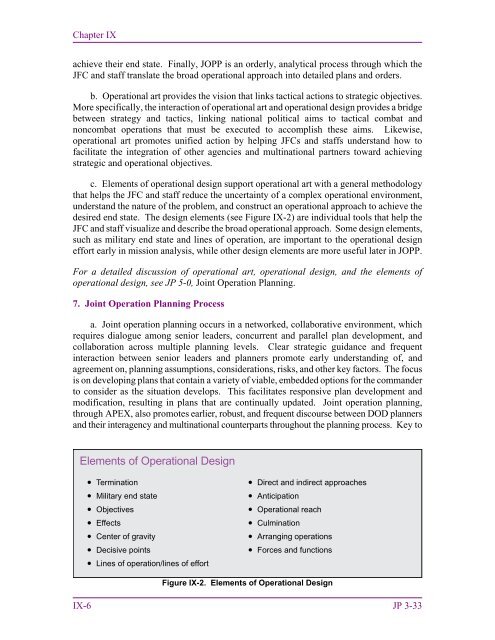JP 3-33, Joint Task Force Headquarters - Defense Innovation ...
JP 3-33, Joint Task Force Headquarters - Defense Innovation ...
JP 3-33, Joint Task Force Headquarters - Defense Innovation ...
Create successful ePaper yourself
Turn your PDF publications into a flip-book with our unique Google optimized e-Paper software.
Chapter IX<br />
achieve their end state. Finally, JOPP is an orderly, analytical process through which the<br />
JFC and staff translate the broad operational approach into detailed plans and orders.<br />
b. Operational art provides the vision that links tactical actions to strategic objectives.<br />
More specifically, the interaction of operational art and operational design provides a bridge<br />
between strategy and tactics, linking national political aims to tactical combat and<br />
noncombat operations that must be executed to accomplish these aims. Likewise,<br />
operational art promotes unified action by helping JFCs and staffs understand how to<br />
facilitate the integration of other agencies and multinational partners toward achieving<br />
strategic and operational objectives.<br />
c. Elements of operational design support operational art with a general methodology<br />
that helps the JFC and staff reduce the uncertainty of a complex operational environment,<br />
understand the nature of the problem, and construct an operational approach to achieve the<br />
desired end state. The design elements (see Figure IX-2) are individual tools that help the<br />
JFC and staff visualize and describe the broad operational approach. Some design elements,<br />
such as military end state and lines of operation, are important to the operational design<br />
effort early in mission analysis, while other design elements are more useful later in JOPP.<br />
For a detailed discussion of operational art, operational design, and the elements of<br />
operational design, see <strong>JP</strong> 5-0, <strong>Joint</strong> Operation Planning.<br />
7. <strong>Joint</strong> Operation Planning Process<br />
a. <strong>Joint</strong> operation planning occurs in a networked, collaborative environment, which<br />
requires dialogue among senior leaders, concurrent and parallel plan development, and<br />
collaboration across multiple planning levels. Clear strategic guidance and frequent<br />
interaction between senior leaders and planners promote early understanding of, and<br />
agreement on, planning assumptions, considerations, risks, and other key factors. The focus<br />
is on developing plans that contain a variety of viable, embedded options for the commander<br />
to consider as the situation develops. This facilitates responsive plan development and<br />
modification, resulting in plans that are continually updated. <strong>Joint</strong> operation planning,<br />
through APEX, also promotes earlier, robust, and frequent discourse between DOD planners<br />
and their interagency and multinational counterparts throughout the planning process. Key to<br />
Elements of Operational Design<br />
• Termination<br />
• Military end state<br />
• Objectives<br />
• Effects<br />
• Center of gravity<br />
• Decisive points<br />
• Lines of operation/lines of effort<br />
• Direct and indirect approaches<br />
• Anticipation<br />
• Operational reach<br />
• Culmination<br />
• Arranging operations<br />
• <strong>Force</strong>s and functions<br />
Figure IX-2. Elements of Operational Design<br />
IX-6 <strong>JP</strong> 3-<strong>33</strong>

















